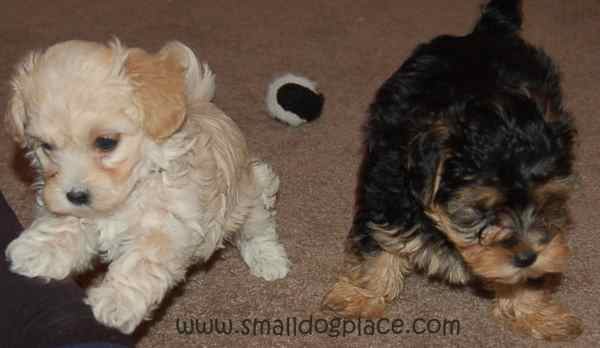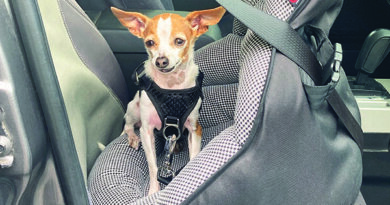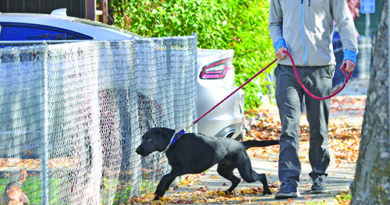Your Dog’s Excitement Urination Getting You Down: Here’s What Works.
By Janice A. Jones | Last Updated January 30, 2020
Excitement Urination and Submissive Urination are two types of urination problems that I have seen sometimes in small dogs. Both are troublesome and discouraging, but there is hope.
While we may not be able to eliminate these problems entirely, we can at least understand why they are happening and what we should and should not do to improve the situation.
Read more about Submissive Urination Here.
 Playful puppies often loose control when they are very excited.
Playful puppies often loose control when they are very excited.What is Excitement Urination?
Some dogs will get so excited when an owner comes home, or a favorite person comes to visit that they urinate in their tracts.
Some get so aroused during an active play session that they can’t help themselves and urinate.
Some are so excited that they don’t even squat. They begin to piddle whether they’re walking, running, standing or still in active play.
Excitement urination occurs in young dogs under a year old and most will outgrow the habit once they gain more control of their bladders. Very excitable puppies are most prone to this type of urination.
What is happening is the urinary sphincter muscle that controls the urine flow temporarily released during excitement causing the dog to loose control. It is similar to a person who is incontinent, but it is a transient happening.
The dog does not have any control over his urinating so punishing him is likely to make the problem worse. In fact, if you punish the puppy for urinating when excited, you will be initiating another type of elimination problem, submissive urination.
How to Deal with Excitement Urination
Since this type of problem usually occurs during periods of heightened excitement such as during greetings, you will want to keep your greetings very low keyed—brief and tranquil.
Stoop down to greet your puppy or turn sideways. Your body language is telling a dog that you are not a threat. Do not make eye contact. Eye contact is very threatening to dogs.
Another approach to try is to stop by the door and let the puppy come to you.
Squat down and pet him behind his ears or under his chin or on his chest. This is good advice to follow whether or not your dog is experiencing excitement urination.
Patting or rubbing a dog’s head is seen as a form of dominance on your part and may lead to more submissive behaviors such as submissive urination as the dog tries to please you.
Never punish the dog in any way. Simply get up and clean up the spot with a good enzymatic cleaner that will eliminate the urine odor.
Teach an alternative behavior that distracts and prevents the dog from urinating.
If your dog loves belly rubs, teach him to roll over for a rub. Alternately, teach him to sit or lie down. All of these doggie positions will prevent him from urinating.
To do this, you may need to keep a bowl of treats by the door and reward with a couple of treats if he obeys the command you request. Usually, a belly rub for dogs that love this type of attention is reward enough.
If you do decide to use this method, remember these pointers:
Excitement Urination Pointers:
- Teach the command that you choose at a time when both of you are relaxed and have time to devote to training.
- Be consistent in your use of commands. Treat each time at first.
- Say the dog’s name and then the command before you get too close to the door. Timing is everything.
- After the dog becomes consistent in obeying the command that you select, ask others to practice it with the dog.
- Reward appropriate eliminations whether they are on a pad or outdoors. Taking him outdoors to eliminate frequently helps keep his bladder empty.
- Help the puppy develop calming behaviors. Slowly stroke his back or belly while holding him close to you. As your body relaxes, you will notice that the puppy is also calming in response to your relaxation.
Eventually, your goal should be to teach a command that you and anyone else could use either with or without treats every time someone comes to the door.
While performing your command, your dog cannot urinate. Sitting and urinating cannot take place at the same time.
Differences between Excitement and Submissive Urination
According to Pat Miller, trainer and author of numerous books on dog training, some behavior professionals consider excitement and submissive urination to be on a continuum of the same behavior, while others make a clear distinction between the two.
Here is our take on the differences.
Submissive Urination
- More common in submissive, fearful or anxious dogs.
- Will show other body language signs of submissiveness such as no eye contact, lowered body, tail tucked between legs.
- Urination may come quickly if greeted by a man with deep voice
- Triggered by people reaching over the head or body or standing over the dog to pet.
Excitement Urination
- Common in puppies
- Happens in confident, happy puppies
- Urinates in a bout of excitement such as greeting people, dogs or active play.
- No difference in the type of people that might trigger urination.
- Less likely to be bothered by someone standing over him to pet.
Ways to Help Prevent Excitement Urination
Since this issue only occurs during periods of high excitement, you can learn to control and prevent it by becoming aware of when it occurs. In many cases, there is a pattern to when the puppy urinates.
- Determine when the puppy loses control. Is it when you come home? Is it when you have visitors? Is it when you are playing a vigorous game? Is it when he’s around other dogs?
- Deal with each different type of situation differently. If the puppy piddles at the sight of you coming home from work, try to make homecomings as calm as possible. I know you are glad to see your puppy, but you might decide to do a few things before you great your puppy. Let him calm down and then great him in a low-keyed way. Treat if no piddling.
- During playtime is difficult because it is easy to get rowdy quickly. Until the puppy matures, encourage play sessions to be fun but calm. Don’t encourage any raucous behavior.
- If the sight of another dog causes problems for your puppy, the best way to introduce the two dogs is for you to hold your puppy and another person holds the other dog. Let them sniff each other but don’t let go until you can feel your puppy relaxing in your arms.
- If your puppy gets excited when visitors come to visit, either
Does This Article Deserve Your Thumbs Up?
We always appreciate your support and encouragement. Your thumbs up means so much to us.

Free Monthly Newsletter
Sign Up for Our Free Newsletter and get our Free Gift to You.
my E-book, The Top 10 Mistakes People Make When Choosing a Dog (and how to avoid them)
If you enjoyed this page, I’d love it if you’d let me know. Just click the button below. Thank you.
Sharing is Caring




